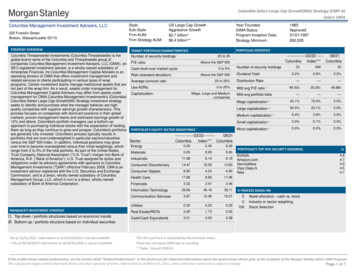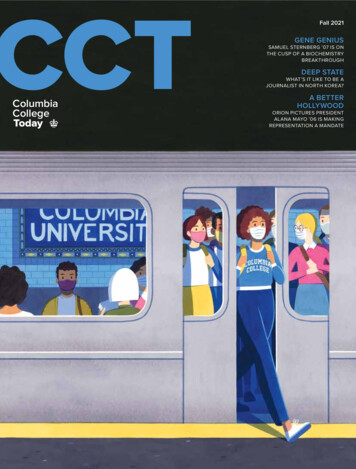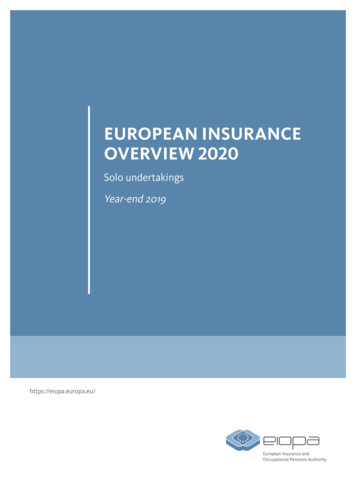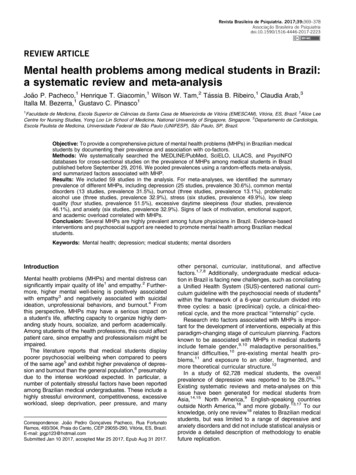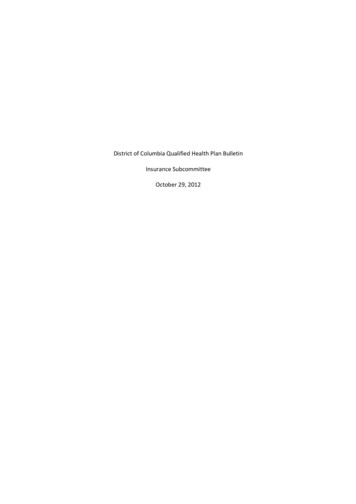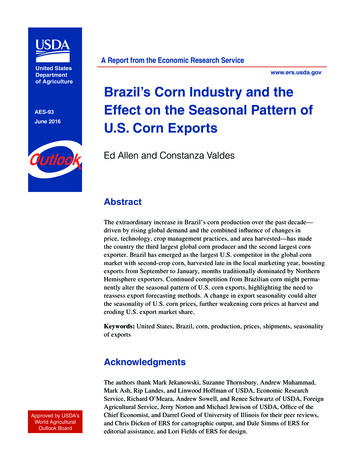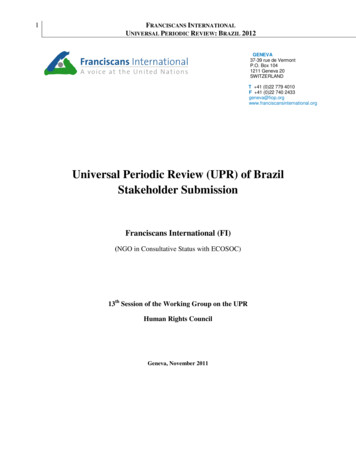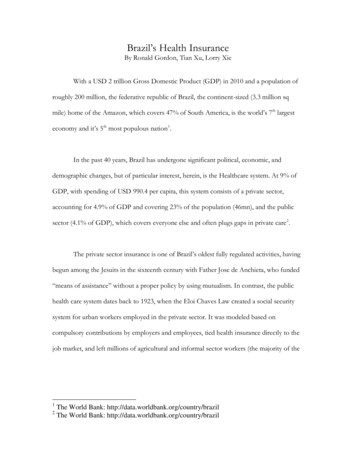
Transcription
Brazil’s Health InsuranceBy Ronald Gordon, Tian Xu, Lorry XieWith a USD 2 trillion Gross Domestic Product (GDP) in 2010 and a population ofroughly 200 million, the federative republic of Brazil, the continent-sized (3.3 million sqmile) home of the Amazon, which covers 47% of South America, is the world’s 7th largesteconomy and it’s 5th most populous nation 1.In the past 40 years, Brazil has undergone significant political, economic, anddemographic changes, but of particular interest, herein, is the Healthcare system. At 9% ofGDP, with spending of USD 990.4 per capita, this system consists of a private sector,accounting for 4.9% of GDP and covering 23% of the population (46mn), and the publicsector (4.1% of GDP), which covers everyone else and often plugs gaps in private care 2.The private sector insurance is one of Brazil’s oldest fully regulated activities, havingbegun among the Jesuits in the sixteenth century with Father Jose de Anchieta, who funded“means of assistance” without a proper policy by using mutualism. In contrast, the publichealth care system dates back to 1923, when the Eloi Chaves Law created a social securitysystem for urban workers employed in the private sector. It was modeled based oncompulsory contributions by employers and employees, tied health insurance directly to thejob market, and left millions of agricultural and informal sector workers (the majority of the12The World Bank: http://data.worldbank.org/country/brazilThe World Bank: http://data.worldbank.org/country/brazil
population) uninsured. 3 Even today, the healthcare system still has a basic division betweenthe poor -who mainly identify as black or brown - and the private sector urban worker.In 1988, following the military rule of 1964-85, when the National Congresselaborated the country’s new constitution, the health sector presented the most completeproposal in terms of governing principles and organization of the system. The constitutionmade healthcare a universal right for all Brazilians and a responsibility of the state. TheSistema Unico de Saude (SUS) or Unified Healthcare System was reinforced and became theregionalized and decentralized network of health services, coordinated at the governmentand community level, and prioritized preventative care. 4The private healthcare market is regulated by the Agência Nacional de Saúde (ANS),the National Health Agency, under the Ministry of Health, whose stated mission is topromote public interest in private health insurance, regulate the operators in the industry –including their relations with providers and consumers – and contribute to the developmentof health in the country 5. The market itself is comprised of numerous entity types: Managed Care Organizations (MCOs) – companies operating private healthcare plansthat usually have owned facilities and third party networks, which is also known as groupmedicine;3American Journal of Public C1447689/4American Journal of Public C1447689/5Agência Nacional de Saúde Suplementar: http://www.ans.gov.br/index.php/aans/quemsomos
Managers – companies that manage private health plans/services for other institutionsand so not have facilities and members; Medical Cooperatives – Not-for-profit institutions that operate private healthcare plans; Philanthropic Institutions – Not-for-profit institutions that operate private healthcareplans and are certified by the Brazilian Council on Social Care; Self-insurer – institutions that provide healthcare coverage only to active/formeremployees and dependents of specific companies, foundations, etc; Health Insurance Providers – insurance companies that provide healthcare plans, subjectto Private insurance Agency (SUSEP) besides ANS regulations; Dental Cooperatives – Not-for-profit institutions that operate private dental care plans; Dental MCOs – companies operating private dental care plans.To put some numbers behind the labels, the market has Medical Cooperatives (36%)e.g. Unimed; MCOs (37%) e.g. Amil, Intermedica & Golden Cross; Insurers (12%) e.g.Bradesco Seguros, Sul America, Porto Seguro; and Others (15%) e.g. Petrobras, Citibank;and administering 44.78 million plans; is now driven mainly by corporate demand (75% oftotal market according to BTG Pactual) 6,7. Incidentally, BTG Pactual, is one of the largestindependent investment banks located in emerging markets and coordinated approximately50% of the total IPSs carried out in Brazil between 2004 and 2011. 86Gewehr, D. & Miranda, L. (2008). Initiating Coverage: Redefining BrazilianHealthcare?7Santos, J. C. & Montenegro, P. (2011). Healthcare Sector – Strong fundamentals.Brazilian macroeconomics and demographics support sector’s sound prospects.8BTG Pactual: www.btgpactual.com
As rendered in the bar chart above, of the roughly 1000 companies issuing healthcarepolicies, 333 companies cover 90% of the market, with around 700 covering the remaining10% (Personal communication on April 17, 2012 with Professor José Antonio Lumertz;Actuary – MIBA 448; Health Commission of the Instituto Brasileiro de Atuaria – Brazil).The figure below illustrates the uneven distribution of private health insurance amongst thefive states of Brazil, by providing information on population distribution and penetration ofprivate healthcare.
The number of small insurers makes sense once you consider the “birth” of manyprivate insurers in Brazil. JC Santos of BTG Pactual (A Brazilian investment bank) hasshared with us personally (April 18th, 2012) how a private insurer is set up in Brazil. First, alocal physician sets up an office by establishing a clinic; then he expands the clinic to build ahospital. In order to increase capacity he creates a health plan for the local people to use thehospital. Even though he’s going underwater with the selling of these plans (because it’s aworking capital business), he doesn’t have this sensation because he makes a lot of money byselling the health plans. As time goes by, the hospital starts to depreciate because he’s notinvesting in the hospital. Since the health plans are the only coverage they have, he needs toextend coverage, but increasing health plan coverage is going to cause him serious troublebecause people may not be able to afford it. Ronald Poon Affat of Tempo Assist (A healthplan insurance company in Brazil), in personal communication on April 18th, 2012, clarifiesthat the majority of the managers of healthcare companies in Brazil are doctors, and theymay not be the best administrators; they do not have the technical skills of a CFO because
they are not properly trained to be one.The Santander Group, the largest bank in the Eurozone and 6th largest company inthe world 9, as determined by Forbes, has republished data by the Brazilian Institute ofGeography and Statistics (IBGE), which found an unsurprising result: the poor – those at 3times minimum wage and below – were not purchasing private healthcare as readily as theupper earning groups (above 3).According to Ronald Poor Affat, from 1997 to today, the same 40 million peoplehave private health plans because these plans are extremely expensive because they have nodeductible or coinsurance. “What Brazil really needs is to have the porche 911 and thevolkswagon beetle”, says Ronald. The current expensive plans kill the hope ofmicroinsurance (insurance that is low premium and low caps or low coverage limits; it is soldas part of atypical risk-pooling and marketing arrangements, and designed to service lowincome people and businesses not served by typical social or commercial al-2000-10 The-Global-2000 Rank.html
schemes). The regulations of Brazil’s health plans standardize all private insurance plans, soall private insurance plans are the same price, i.e. very expensive, so the regulation is killingthe opportunity for microinsurance and pricing efficiency, and consequentially, it ishampering the penetration into lower income brackets.Once someone is in the middle class, however, he or she will want to buy privatehealth insurance. According to JC Santos, “having private healthcare coverage is the secondmost desirable item in Brazil after having your own house.” It has became a signature of themiddle class. So if the government can create a boom in the jobs, and help people get intothe lower middle class, then, they will be buying health plans.On the other hand, the public sector, which is now funded by federal resourcesoriginating in a pool of value-added, general income, financial operations and taxes(insurance, export and import), is currently 7.1% of Government spending 10.Healthcare, for both Brazil and the US, is not completely unalike. For one, bothcountries’ healthcare systems are split into public and private sectors. Additionally, theirprivate health insurances are regulated by the government but provided privately and thegovernments handle public health insurance. The crucial difference between the twosystems, however, lies in the uninsured. Brazil technically doesn’t have any, but the numberof uninsured in the US is increasing steadily (see graph below).10The World Bank: http://data.worldbank.org/country/brazil
Brazil’s healthcare system was ranked 125th by the World Health Organization(WHO). The WHO qualifies that “Brazil, a middle income nation, ranks low in the tablebecause its people make high out-of-pocket payments for health care. This means asubstantial number of households pay a large fraction of their income (after paying for food)on healthcare.” This expense (which results not from ex ante choice, as with insurance, butrather from ex post need) represented 6.8% of family income in the lowest decile, and itsshare was inversely proportional to income; it accounted for only 3.1 percent of income inthe highest decile. If out-of-pocket spending is subtracted from income, the proportion ofindigent increases by 1.4 percentage points. This change, though it may seem small,illustrates the effect of out-of-pocket health payments on population income. This is notable
because it shows that to some degree, Brazilian health policy increases poverty, as a result ofthe inequity of out-of-pocket spending 11.Other than Santander, the US Society of Actuaries, global consulting firms such asTowers Watson, and global banking and financial services companies such as Deutsche Bankare all analyzing Brazil’s healthcare. Additionally, these corporations are also keeping track ofBrazil’s medical trend. A Towers Watson report indicates increased medical trend net ofinflation of 0.5% from 5.0% in 2006 to 5.5% in 2009. This trend is in line with the rest ofLatin America and the developing nations, but it is much less than the trend found in themore developed nations.The increased medical trend signals a greater need for risk distribution channels andthe Brazilian Reinsurance market is developing in tandem. The Brazilian insurance markethad been operating under a monopolistic reinsurer since 1939, when the governmentsponsored Instituto Brasileiro de Resseguros (IRB) was created to reinsure the local marketparticipants and to regulate the reinsurance market. On December 17th, 2007, the PrivateInsurance Superintendent (SUSEP) issued Resolution CNSP 168 and the Brazilianreinsurance market was formally opened for the international players. This regulation allowsfor three types of reinsurers: local, admitted and occasional. Local reinsurers are companiesthat operate in the local reinsurance market through a local incorporated and capitalizedcompany; admitted reinsurers are foreign reinsurers that choose to operate directly in Brazilthrough a local representative office; and occasional reinsurers are foreign reinsurers not11Health Affairs: an analysis of equity in Brazilian health system /26/4/1017.full
having a local representative office (but with a local proxy or power of attorney) that wish todo reinsurance business in Brazil.A key regulatory constraint, used as a way to prevent substantial capital outflow fromBrazil, is that neither insurance companies nor reinsurance companies are allowed to cedemore than 50% of total written premiums – except for credit, surety and agriculture/ruralinsurance. This requirement reduces the possibility of large inter-company cessions/poolarrangements and induces companies to maintain sound underwriting policies and controlsat the local level.With changes in the healthcare system and the desire to minimize risks, actuariesbecome more and more crucial in formulating policies, especially for insurance andreinsurance companies. The Brazilian Institute of Actuaries (IBA), founded in 1944, is thenational association for actuaries and the only entity representing the profession in thecountry, and there are about 700 active MIBA (members of the IBA). Only 60-70 actuarieswork in the healthcare sector (personal communication from Ronald Poon Affat).The Brazilian Institute of Actuaries (Instituto Brasileiro de Atuaria), founded in 1944and established in Brazil’s second largest, but most visited city, Rio de Janeiro, is the nationalassociation for actuaries and the only entity representing the profession in the country. Amember of the International Actuarial Association (IAA), the IBA, consequently, has adefined minimum standard syllabus for each Actuarial Science course and an IBA memberadmissions exam available to anyone graduated from or enrolled in an undergraduateactuarial science program recognized by the appropriate authority.
Before the liberalization of premiums in 1992 and the obligation for calculation ofIBNR (Incurred But Not Reported) reserves in 1998, actuaries' activities were mainly relatedto complying with legislation (e.g., describing new products to the regulator, but they rarelycalculated the premium). But currently, actuaries can be found controlling companies,something that would have been difficult to imagine in the past. They are also responsiblefor conducting annual valuations of pension companies and valuations twice a year forinsurance companies and health insurance providers. Actuaries are in high demand for theoperation of companies because a company can only register its insurance products or makeany changes to them if actuaries “agree”, and it must be an actuary who is responsible forany changes to company reserve levels.Even with these changes, there still aren’t very many American or British actuaries inBrazil. Ronald Poon Affat contends that because the is not much data to work with, whatyou need to be successful as an actuary in Brazil is 75% understanding the business, theenvironment, the products, and 25% of strong technical background – understanding goodand bad business, pricing, loss ratio considerations, etc. It has been his experience that theactuarial skills developed in England and America, which required large amounts of data fordecision development, did not translate well to Brazil. Personally, Ronald makesassumptions, prices and then executes and checks the parameters against experience. Forinstance, if he makes a loss ratio assumption, he keeps testing it every month or every threemonths.
Though much has improved in the past three decades for Brazil’s healthcare system,the SUS is still struggling to enable universal and equal coverage for everyone. The unevendistribution of out-of-pocket costs as a percentage of total income, where the lower incomegroups pay disproportionately much more for medicines prescribes as part of the publichealthcare system and for private healthcare, is a serious problem. The healthcare system is,in this way, an unfortunately impoverishing force. Moreover, Brazil’s government needs torevise its financial structure to give its citizens (low-income citizens especially) more reasonsto buy healthcare insurance. To this effect, change must be made in the legislation to allowthe creation of more diverse plans, allowing for microinsurance, and ensuring the poor canafford coverage.Also, there are difficulties with the private insurer consolidation process. In Brazilthere are too many insurance companies (including a lot of medical cooperatives) that lackprofessional management and underwriting; are not profitable; but which, for some regions,are the sole players/ provider network because they have hospitals. The quality andstandards of the services are quite low by consequence. Furthermore, we don’t expect to seeexpedited growth in these areas because of regional boundaries (Personal communicationwith Ronald Poon Affat).Insurance companies are buying out other companies, but when they do, they don’thave the money to continue the reserves. And they don’t have the money to continue thereserves for the provider networks that you have on the outskirts of Brazil. So how can youforce someone to go out of business that would, eventually, lead to the bankruptcy of the
hospitals you have in that specific region? It’s a very complicated matter. Even to force theirconsolidation by local companies like Temporal, Amil, Intermedica is somewhat treacherous.On the issue of hospitals, on average, the hospitals in Brazil are quite small. This isnot ideal. There is a strong dominance of non-profit organizations and they are definitely notgrowing at the same pace as private healthcare coverage. Crucially, a law in the constitutionprohibits foreign capital investment in hospitals; and though the National Private HospitalsAssociation is currently investing a lot in hospitals and hospital beds, and though there hasbeen a positive trend in private players and a negative trend in not-for-profit institutions, achange in the regulatory environment, allowing foreign investment, would definitelyaccelerate the process.Some companies are investing in the verticalization of healthcare – that is, theintegration, under one company umbrella, of various aspects of the healthcare system, likehospitals, doctors, ambulances etc. – the result should be cheaper healthcare.One of the main proponents of verticalization is Intermedica, the largest player that isfocused on those with lower income. At 50%, they have a level of vertical integration that ismuch higher than anyone else in the market. Similarly, Amil, which is the largest player in theregion, has 25% vertical integration. With this level of integration, you can control costs andhave lower average premiums being charged.In terms of verticalization the market is starkly divided. Tempo Assist, the companyfor which Ronald Poon Affat works, in contrast to Intermedica and Amil, doesn’t ownanything. Naturally, due to non-ownership, they rent everything in their network, having
contracts with hospitals, contracts with dentists, with ambulances; they have nothing on theirbalance sheet, which leaves them completely flexible.Ronald is not convinced that the process of verticalization will work, but he says theBrazilians are giving it a run for their money; and if they do it, they will invent cheaphealthcare.Special thanks to Ronald Poon Affat of Tempo Assist and JC Santosof BTG Pactual, without whom this paper would not haverepresented the depth and life of the Brazilian healthcare system.Their contributions were invaluable.
REFERENCES2011 Global medical trends (2011). Tower Watson. Available athttp://www.towerswatson.com/ united-states/research/3585Agarwal, S., d’Almeida, J.,& Francis, T. (2012). Capturing the Brazilian pharmaopportunities. McKinsey Quarterly. Available athttp://www.mckinseyquarterly.com/Health Care/Pharmaceuticals/Capturing the Brazilian pharma opportunity 2944Agência Nacional de Saúde Suplementar: il (2012). Brazil statistical data. Available at http://data.worldbank.org/country/brazilBrazilian reinsurance market: open at last (n.d.) Latin lawyer 7(4), 1-2. Retrieved insurance.pdfCasualty Actuarial Society Latin America Regional Committee (2012). Information onBrazil. Retrieved a brazilinfoElias, Paulo E. M., and Amelia Cohn. "Health Reform in Brazil: Lessons toConsider."American Journal of Public Health. Jan. 2003. Web. 16 Apr. 2012. 9/ .FACTBOX: Healthcare costs in U.S. vs. rest of world (2009). Reuters. Available atwww.reuters.com/article/2009/06/01/us‑ healthcare‑ costs‑ sb‑ idUSTRE5504Z320090601Gill, K. (2008). Health Care In The U.S. ‑ Issue Overview, The Health Care System.Available at uspolitics.about.com/od/healthcare/tp/health care overview.htmGribble, J.D. (2006). Actuarial Supply and Demand. Retrieved Paris/Actuarial Supply Demand.pdfHealth care in Brazil: An injection of reality (2012). The Economist. Available atwww.economist.com/node/21524879Health, doctors, hospitals and the medical system in Brazil (2012). AngloINFO.Available care.asp#healthsystem
Levy, A. & Pereira, F.C. (n.d.). Recent developments in Brazilian insurance market, 743787. Retrieved from .pdfMercedes, L.S & Ixer, S. (2011). Brazilian Reinsurance: A Swinging Door. LatinAmerica Law & Business Report 19(6), 1-2. Retrieved zilianReinsuranceArticle.pdfNew rules for Brazilian reinsurance (2011). International Alert (46). Available atwww.willis.comOpening of the Brazilian reinsurance market – a new beginning (2008). Moody’s GlobalInsurance. Retrieved from http://www.moodys.com.br/brasil/pdf/2008 04Opening of Braz Reinsurance Mkt.pdfPoon, R.A (2012). Brazilian Reinsurance Regulation Changes Again. Reinsurance News(72), 24-27. Retrieved from oon, R.A. & Noguti, H.H. (2011). Brazilian Reinsurance Market Update. ReinsuranceNews (70), 16-19. Retrieved , R.H (2012). Brazilian private health care market—ready for liftoff. InternationalNews (55), 12-18. Retrieved Santos, J. C. & Montenegro, P. (2011). No rush to play the secular theme in 2011.Available at www.btgpactual.comSantos, J. C. & Montenegro, P. (2011). Healthcare - initiating coverage. Available atwww.btgpactual.comU.S. Health Care's Competitive Disadvantage. (2012). Bloomberg Businessweek.Available 2009/db20090312 554568.htmWheatley, J. (2008). Focus on Brazil. Risk Specialist, 18-21. Retrieved fromhttp://www.jltgroup.com/content/UK/risk and insurance/Risk Specialist Articles/Focus on Brazil090408.pdf
Brazil's Health Insurance By Ronald Gordon, Tian Xu, Lorry Xie . . (SUS) or Unified Healthcare System was reinforced and became the regionalized and decentralized network of health services, coordinated at the government . Ronald Poon Affat of Tempo Assist (A health plan insurance company in Brazil), in personal communication on April 18 .
